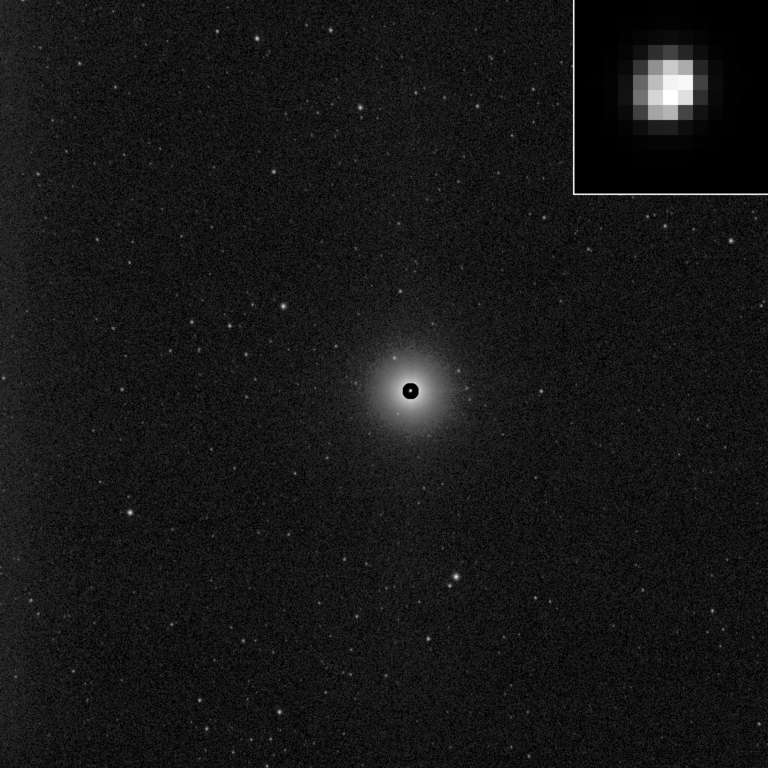Emily Lakdawalla • Jun 19, 2014
Rosetta completes another rocket burn, spies decreasing activity on comet
Rosetta has now completed its three largest rendezvous burns as it approaches ever closer to comet 67P/Churyumov-Gerasimenko. Yesterday's slowed it by another 89 meters per second, leaving it with only slightly more than 100 meters per second excess speed with respect to the comet. Beginning on July 2, Rosetta will now conduct weekly burns, through August 6.
Meanwhile, the cometary activity that 67P/Churyumov-Gerasimenko showed in April and May has quieted again, leaving the comet looking smaller than it did before. We already knew comets that, but it's still exciting to witness such variability up close. Here's a newly released photo, taken two weeks ago on June 4. I cropped the original image closer around the comet and enlarged it by a factor of two with nearest-neighbor sampling to preserve the appearance of the original pixels. Still just a smudge!

Now, I would like to see the change in cometary activity for myself, so I would like to compare the photo above to the one from a month previously, on April 30. But if you look at the April 30 photo below, you will see that there are more stars in it, which should be a clue to you that it's not an apples-to-apples comparison. The image captions on the ESA website contain the explanation: the April 30 photo had an exposure time of 720 seconds; the June 4 one, only 67 seconds. The longer exposure of the April 30 photo reveals more faint stars and also more faint coma. So I'll put the April 30 photo here, but I'll warn you that you can't directly compare the two to study the relative activity of the coma.

Today is the day that Rosetta passes across the resolution threshold where the comet's nucleus should be larger than one OSIRIS camera pixel. Rosetta is still too far away to see any details on the comet's surface -- you need more pixels for that -- but the nucleus will grow with every passing day. Along with the release of this image, ESA said "The next image is foreseen on or around 3 July, and then on a weekly basis until rendezvous on 6 August. The images will be published in the Rosetta image gallery and via the Rosetta mission blog." So that is, hopefully, six more images to look forward to this summer.
OSIRIS is not Rosetta's only camera. There is an ESA-owned camera as well, the Navcam, which has much lower resolution than OSIRIS but which should by now be spotting the comet as well; an earlier Rosetta blog said they'd start taking Navcam photos for operational purposes in May. I've asked about those images but I know of no plans to release them.
I was curious about how Rosetta approach images of 67P compare to Dawn approach images of Vesta. The comet and Vesta are very different sizes: 4 and 560 kilometers, respectively. So the same camera would have to be 140 times closer to 67P in order to see as many pixels across the disk as it would on Vesta. But Dawn's Framing Camera and Rosetta's OSIRIS NAC don't have the same resolution. Dawn FC pixels are 96 microradians, while OSIRIS NAC's are 18.6 microradians. So that offsets the difference a little bit. For Rosetta to see as many pixels across the 67P nucleus as Dawn saw at Vesta, Rosetta needs to be 27 times closer. Dawn's first images of Vesta were taken from a distance of 1.2 million kilometers, and showed a spot a few pixels across. 67P will appear a similar size to Rosetta when it is 44,000 kilometers away, which will happen in the first week of July.

Let’s Go Beyond The Horizon
Every success in space exploration is the result of the community of space enthusiasts, like you, who believe it is important. You can help usher in the next great era of space exploration with your gift today.
Donate Today

 Explore Worlds
Explore Worlds Find Life
Find Life Defend Earth
Defend Earth

